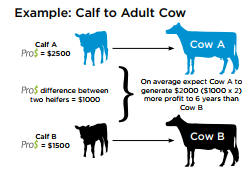Although purchasing genetics is an expense on your financial ledger, genetics are an investment in the future profitability of your dairy farm. So take a moment to think about how you make the purchasing decisions on the genetics for your dairy herd. Every farm will have their own breeding philosophy and most will want to purchase the best product at the lowest price. The reality, however, is when you go for the best deal; you do not always get the best value.
Farms should consider setting a genetic budget for a defined timeline. Maybe it is an annual budget, or maybe it is a timeline that coincides with Proof rounds. Once you have identified what your genetic budget will be, then you can work with your genetic advisor to make a genetic plan and to implement strategies to effectively advance the genetic progress of your dairy herd.
Some Genetic Strategies to consider that will help deliver your needs and goals:
- Manage Inbreeding – keep accurate records to help manage inbreeding. Inbreeding can reduce the productivity and profitability of your herd.
- Use of sexed semen – Producers can select the top animals in the herd and use sexed semen to improve the genetics of the next generation while providing enough replacement animals to increase the voluntary culling rates.
- Use of Beef Semen or embryos – Producers can select the bottom animals in their herd and either use beef semen or embryos to prevent the lowest animals from participating in the creation of future replacements.
Genomically Tested Embryos are now available: a potential profit driver for your herd
 Genomically tested embryos that have predetermined sex and TPI/LPI levels are now available for purchase by Canadian dairy producers. Incorporating genomically tested embryos into your genetic plan is a sound strategy to help drive increased profits from your herd in the first generation and every generation
Genomically tested embryos that have predetermined sex and TPI/LPI levels are now available for purchase by Canadian dairy producers. Incorporating genomically tested embryos into your genetic plan is a sound strategy to help drive increased profits from your herd in the first generation and every generation
that comes after. Genetic gain in herds is accelerated by increasing the focus of using best products on highest genetic-merit animals. It is further accelerated by preventing the lowest animals from participating in the creation of future replacements (through beef semen or by carrying embryos). The genetic difference in the embryos on offer compared to the calves that would be created from mating these lower-end heifers to top-rated sires is expected to exceed 1000 points on the Pro$ scale, which means expected lifetime profit difference would exceed $2000 (see adjacent example). A benefit in future generations adds further value. Resulting calves would in many cases provide the genetic engine for future conventional or IFV work to continue the process.
Conclusion:
Evaluating sire selection criteria, breeding decisions and setting a genetic budget should be an annual task. A successful genetic plan starts with accurate identification of the animal itself as well as the sire and dam information of the animal. Evaluation of the genetic program will allow dairy producers to make informed mating decisions, where sexed semen, beef semen and embryos can play a role. The genetic tools available today will help you optimize inputs and maximize your returns.
Val Holbech, BC Holstein News, December 2017



Leave A Comment
You must be logged in to post a comment.